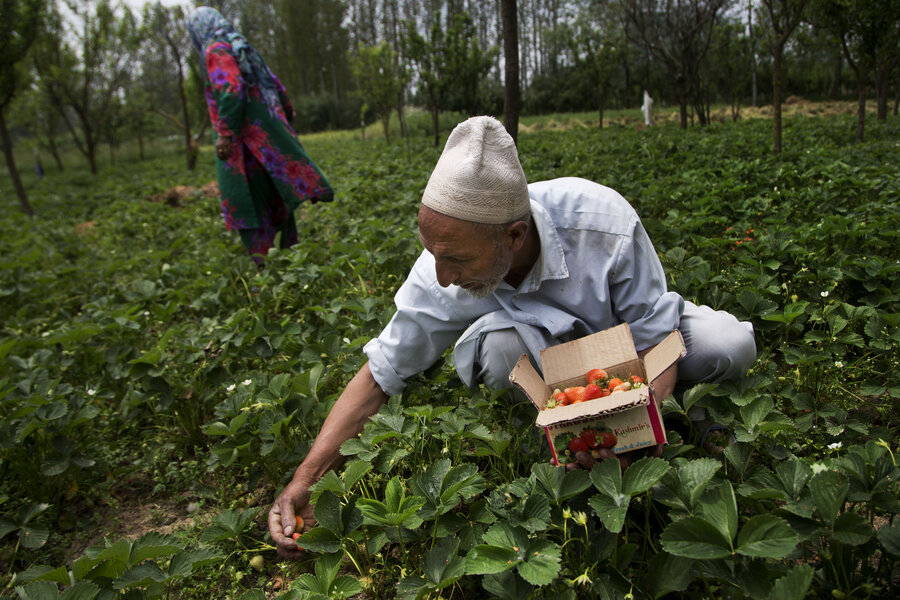Why the Paris Agreement won't succeed without agricultural innovations
Loading...
Even if the agricultural industry perfectly implemented all of today's emission-reducing practices, greenhouse gas emissions from agriculture would still block the climate goals of the United Nation's Paris Agreement, a recent study finds.
To limit global temperature increases to 2 degree Celsius, as set forth by the Paris Agreement in December, non-carbon dioxide emissions from the agriculture sector – such as methane and nitrous oxide – need to be reduced by one gigaton per year by 2030, the authors write.
"Without the guidance of a 2°C-based goal in agriculture, much effort will be driven by what is technically or politically feasible, rather than by what is necessary," the researchers report in a paper published Tuesday in the journal Global Change Biology.
And simply implementing what is only "technically or politically feasible" offers "a fraction of the mitigation needed" to reach the temperature goals set in Paris, they say.
In their study, the team of researchers found a surprising gap: Even if all of today's "best practices" were implemented, only 20 to 40 percent of agriculture's emissions would be eliminated.
"And this assumes that we have wall to wall implementation [of current strategies] to reduce by 20 to 40 percent – so even that is a huge effort," Dr. Lini Wollenberg, a professor at the University of Vermont's Gund Institute for Ecological Economics and a co-author of the paper, tells The Christian Science Monitor. "We were shocked at how hard it would be to meet the one gigaton of CO2 goal with current technology."
Examples of already acknowledged solutions include reducing food waste, using water efficiently in rice production, utilizing agroforestry practices, and sustainable livestock production. Food waste in 2012 had a carbon footprint of 3.3 gigatons, meaning that if this waste was a country, it would rank third behind the United States and China in greenhouse gas emissions.
And while these are meaningful reduction methods, they are not enough. The 34 researchers from organizations across the world hope their study will add a new sense of urgency for politicians, innovators, and scientists about the need for new mitigation strategies to fight agricultural emissions.
"The large gap between desired mitigation outcomes and plausible outcomes indicates that more transformative technical and policy options will be needed to reduce non-CO2 emissions or that mitigation from other sources will be needed to offset them," the authors write in their paper. "New low emissions technologies are in the pipeline for agriculture, but vastly more effort and urgency is necessary to make options operational."
Some of these proposed technologies include new strategies for raising both livestock and crops. Researchers are looking to identify specific cattle breeds that produce less methane, a dietary inhibitor for cattle that reduces their methane emissions by 30 percent; specific wheat and maize crops that have lower nitrous oxide emissions; and certain soil practices that help the soil retain carbon for a longer period.
"We need to help farmers play their part in reaching global climate goals while still feeding the world," says Prof. Pete Smith, theme leader for environment and food security at the University of Aberdeen in Scotland and co-author of the paper, in a press release. "A lot can be done with existing best management practices in agriculture. The tough part is how to reduce emissions by a further two to five times and support large numbers of farmers to change their practices in the next 10 to 20 years."
However, the US has bigger emission sources to tackle when it comes to climate change, such as electricity and transportation. The US Environmental Protection Agency (EPA) says the agriculture sector contributes 9 percent of all US greenhouse gas emissions – the smallest of all five sectors listed by the EPA.
But as Dr. Wollenberg points out, agriculture emissions look far more serious when zoomed out to an international level.
While agriculture emissions may be only 9 percent of the total greenhouse gas emissions in the US, agriculture contributes an average of 30 percent to all countries' total emission number. Many African nations have low emission rates, for example, but agricultural practices contribute to a significant portion of the country's overall rate, sometimes as high as 80 to 100 percent. In 42 countries, agriculture contributes to more than half of the overall greenhouse gas emissions.
"If agriculture is not included in mitigation scenarios we won't be able to achieve any of these targets. Not 2 degrees, much less 1.5 degrees," adds Wollenberg. "What this study is saying essentially is that to reach the 2 degree target that everyone has already agreed to, agriculture has to be considered as part of the mitigation solution. Agriculture has to do much more."








